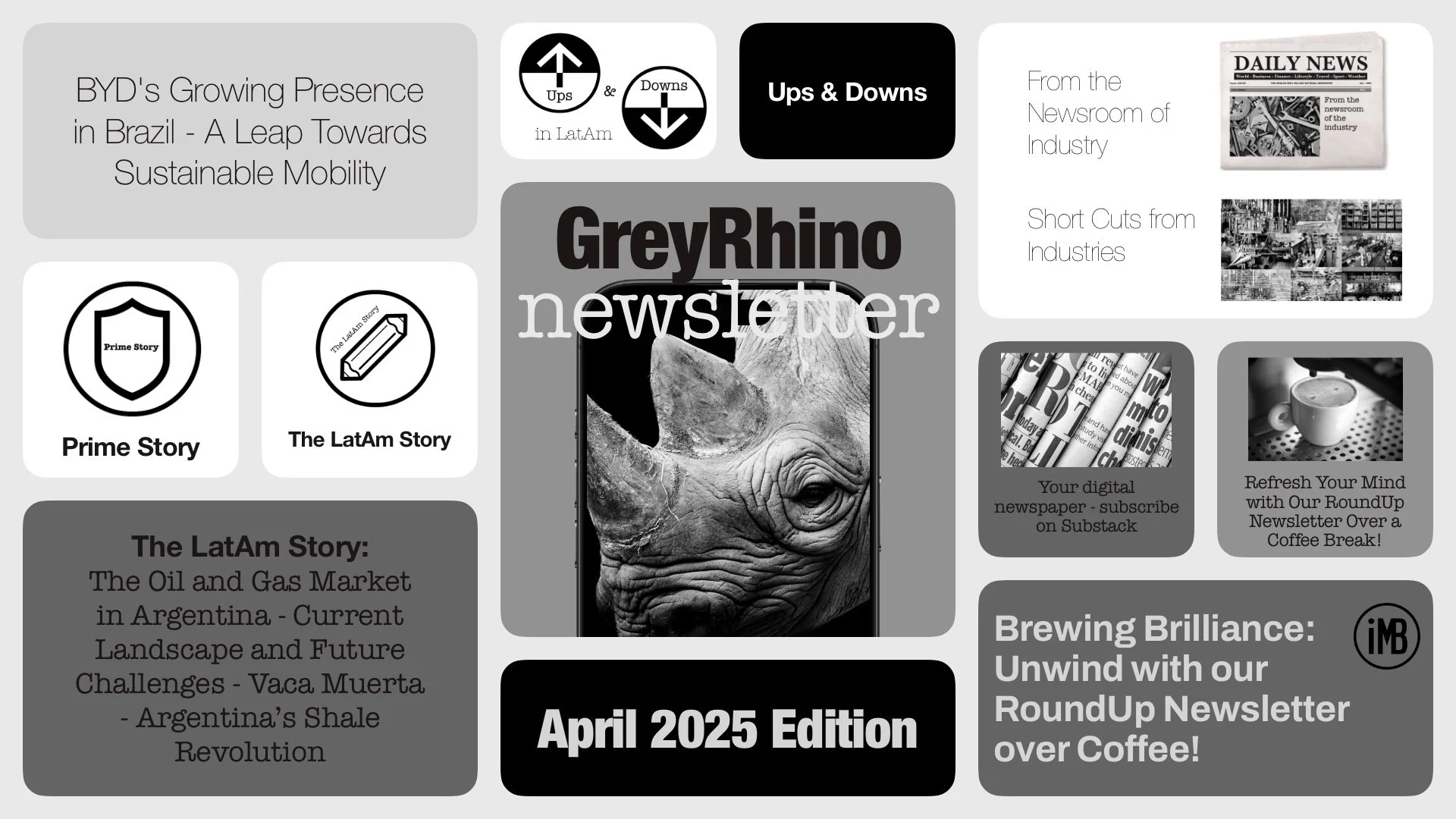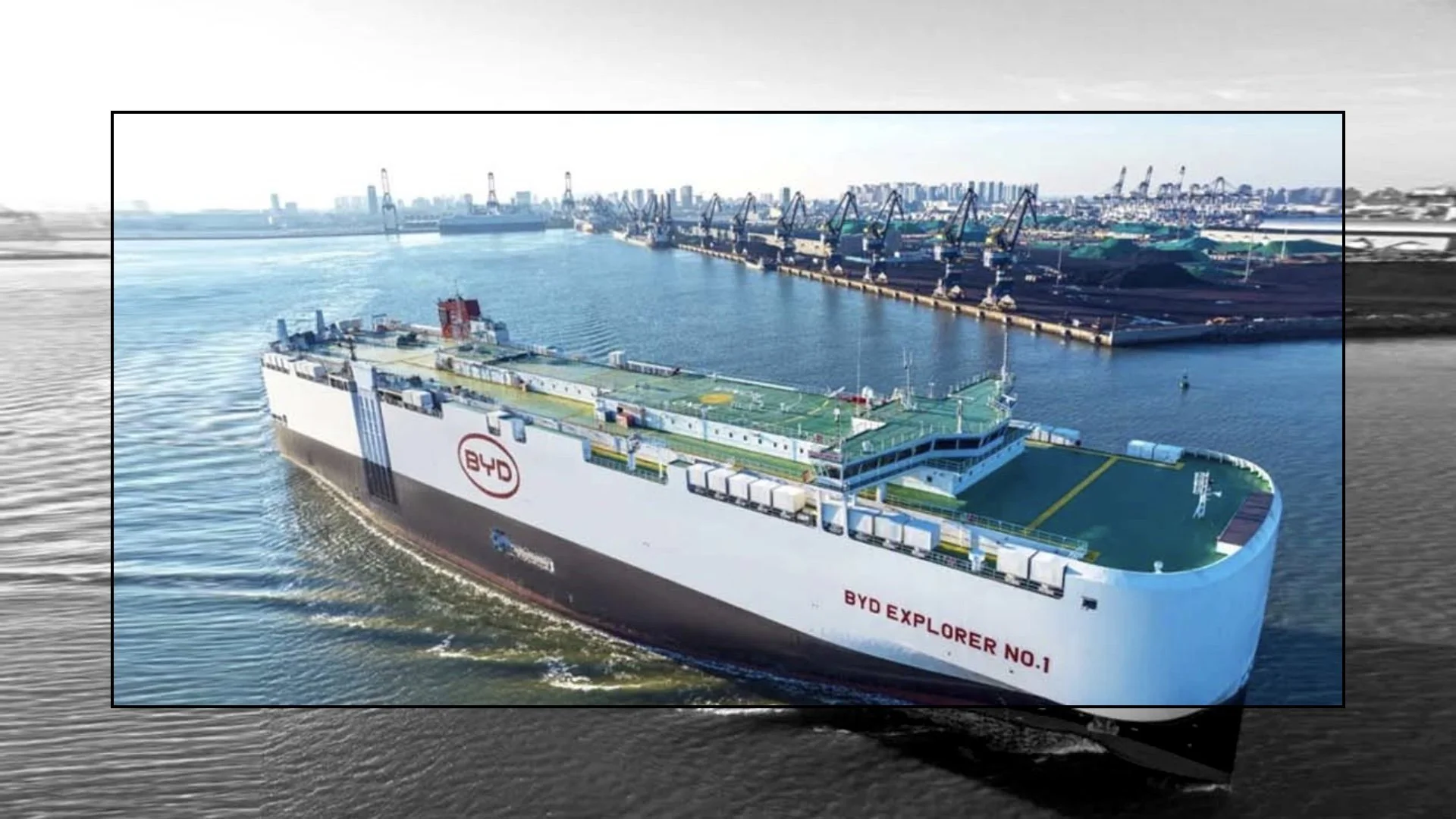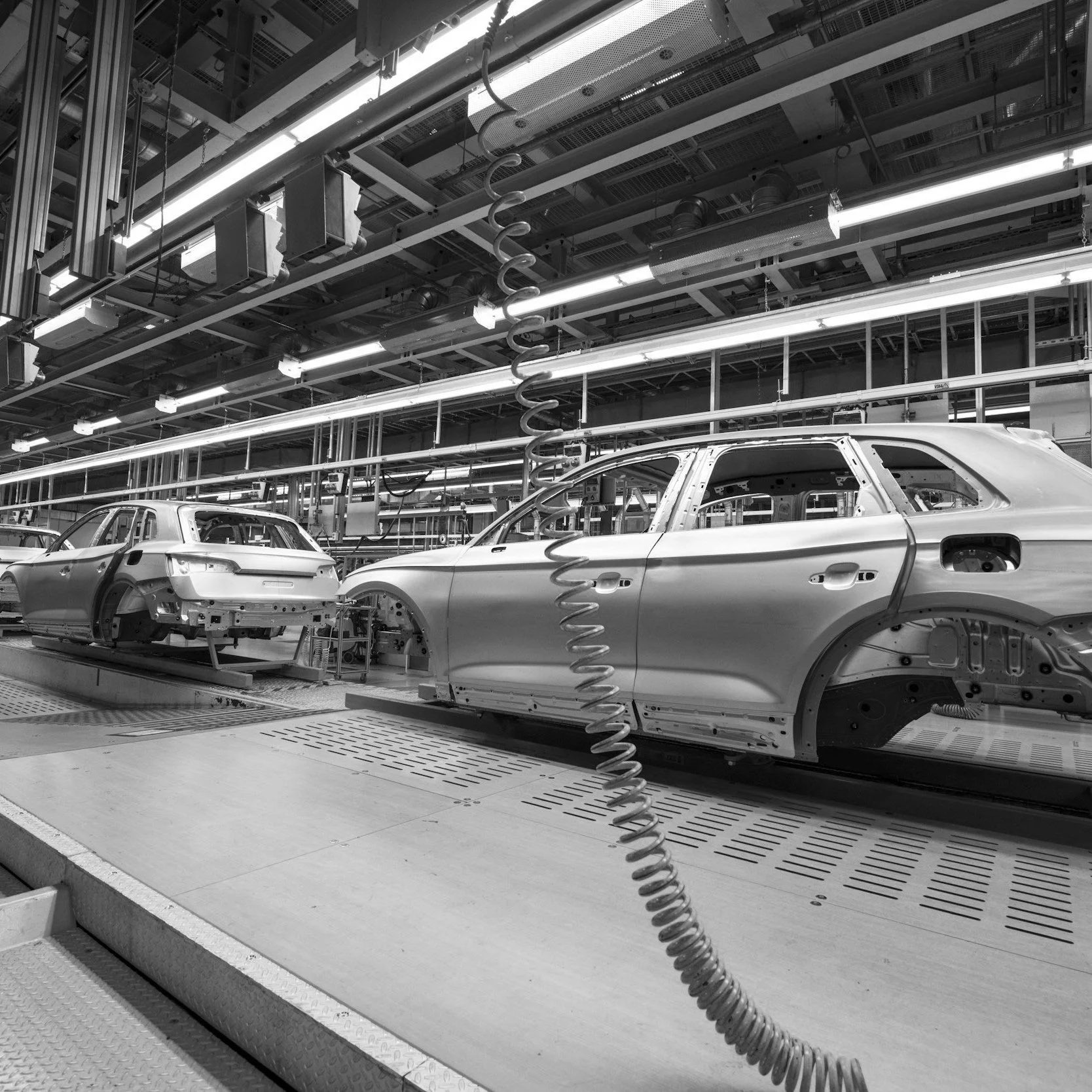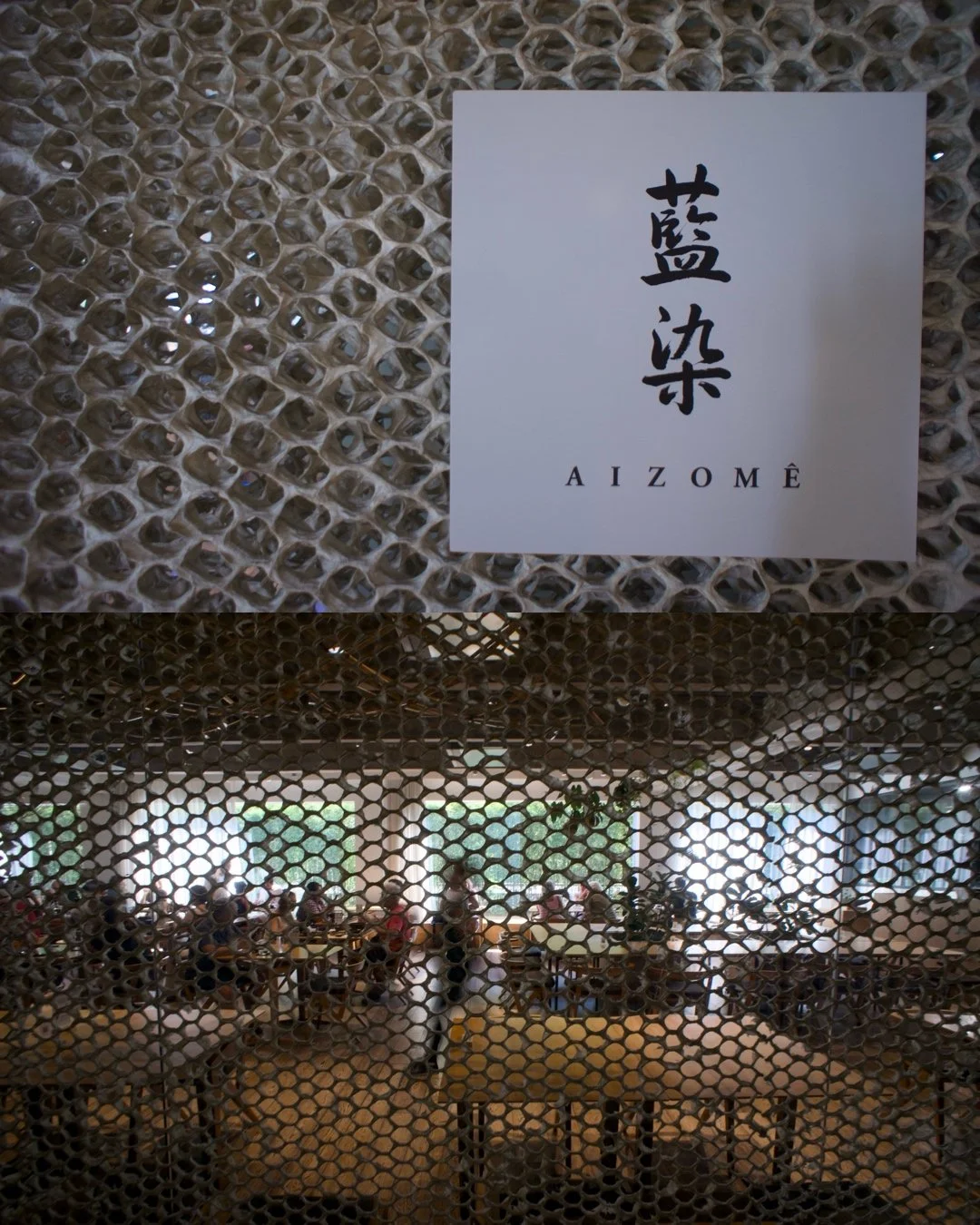GreyRhino newsletter Edition April 2025
Discover the GreyRhino Newsletter by iMB.Solutions!
Stay ahead of the curve with the GreyRhino newsletter, your go-to source for insightful analysis and expert commentary straight out of the project missions. Curated by iMB.Solutions, this newsletter dives deep into the "grey rhino" events—highly probable, high-impact threats that we often overlook.
Why Subscribe?
Expert Insights: Gain access toiMB's unique perspectives and in-depth analysis straight out of our projects.
Timely Updates: Stay informed with the latest developments and trends that could impact your business and personal life.
Actionable Advice: Learn practical strategies to navigate and mitigate risks, ensuring you're always prepared for what's next.
Join a community of forward-thinking professionals who are committed to staying informed and proactive. Don't miss out on the valuable knowledge and insights shared in the GreyRhino newsletter.
Subscribe now on iMB.Solutions webpage and turn potential threats into opportunities!
Type your email and smash the subscribe button!
Prime Story
automotive industry - Brazil
BYD's Growing Presence in Brazil - A Leap Towards Sustainable Mobility
BYD is accelerating its footprint in the Brazilian automotive market, marking a significant transformation in the realms of electric and hybrid mobility. With impressive shipments, ambitious local production plans, and robust market performance, BYD is set to redefine sustainable mobility in Brazil. Here’s a deep dive into how this Chinese automotive giant is making waves in the country.
A New Chapter in Logistics: The BYD Explorer No. 1
At the heart of BYD’s expansion is its state-of-the-art car transporter, the BYD Explorer No. 1. In late February 2025, this colossal vessel docked at Portocel in Espírito Santo, unloading over 5,500 electric and hybrid vehicles from the popular Dolphin, Song, and Yuan families. This move not only highlights BYD's commitment to sustainable transport but also underscores its innovative logistics strategy, using its own fleet of cargo ships to ensure timely, efficient deliveries to key markets.
Pioneering Local Production in Camaçari
In a strategic pivot from imports to local manufacturing, BYD is transforming the former Ford factory in Camaçari, Bahia. This facility is on track to become BYD’s largest production hub outside of China with:
Initial Capacity: 150,000 vehicles annually
Expansion Potential: Up to 300,000 vehicles per year in the second phase
This local production initiative will not only streamline BYD’s supply chain but also tailor products specifically for Brazilian consumers while reducing dependency on imports.
Milestones and Market Impact
BYD’s growth in Brazil is evident:
Record Shipments: The initial 5,500-vehicle shipment in May 2024 at Suape, Pernambuco, set a record and paved the way for accelerated imports ahead of rising tariffs.
Market Penetration: By January 2025, over 100,000 BYD vehicles were registered in Brazil, positioning the company among the top 10 automotive brands in the country.
Sales Surge: A staggering 272% increase in sales in 2024 compared to the previous year demonstrates strong consumer confidence and market acceptance.
Strategic Shifts: From Imports to a Local Ecosystem
The launch of the Camaçari plant is expected to bring significant changes in BYD’s operational strategy:
Reduced Dependence on Imports: With local production ramping up, BYD will rely less on importing finished vehicles from China.
Component Imports Transition: While vehicle imports will decline, there will be a strategic shift towards importing critical components, gradually offset by increased use of locally sourced parts (targeting 25% of the vehicle’s cost).
Tariff and Infrastructure Considerations: Despite current challenges with tariff exemptions on equipment, BYD’s long-term vision is to optimize its local supply chain.
Continued Use of Proprietary Logistics: The BYD Explorer No. 1 will still play a key role—this time in transporting components and machinery essential for local production.
BYD Explorer No. 1, Source: BYD Corporation, 2025
The Investment Ripple Effect
Increased sales are fueling a robust investment cycle:
Market Confidence: Record growth reinforces BYD’s commitment to Brazil, encouraging further capital investments.
Production Expansion: Success in the market justifies accelerating local production to meet rising demand with vehicles tailored to local tastes.
Infrastructure Boost: Higher sales support additional investments in charging networks and technological upgrades, exemplified by partnerships like that with Raízen Power to deploy 600 fast chargers nationwide.
Economic Impact: The creation of over 10,000 jobs is not only a testament to BYD’s commitment to the Brazilian economy but also a catalyst for broader market expansion through improved consumer spending and robust local supply chains.
Strengthened Partnerships: BYD’s growth has led to strategic collaborations with local suppliers and government entities, further cementing its market position.
A Global Strategy with Local Nuances
BYD’s approach in Brazil contrasts with its strategies in other regions:
Brazil: Emphasizes heavy investment (R$ 5.5 billion), local production, and market adaptation to avoid high import tariffs and cater to Brazilian preferences.
ASEAN Countries: Focuses on establishing localized production bases primarily for exports, rather than addressing a domestic market of Brazil’s scale.
Europe: Represents a future market, where localized production (e.g., in Hungary) is planned to meet regulatory demands and competitive challenges.
Driving Confidence: Why Brazil?
Several factors boost BYD’s optimism in the Brazilian market:
Rising Demand for Clean Energy: Brazil’s growing interest in sustainable technology aligns perfectly with BYD’s electric and hybrid offerings.
Government Incentives: Initiatives like the Green Mobility and Innovation Programme offer attractive tax incentives for low-emission technologies.
Competitive Edge Through Local Production: By manufacturing locally, BYD sidesteps high import tariffs and customizes its vehicles to meet regional needs.
Affordability: Competitive pricing of models like the Dolphin has resonated well with Brazilian consumers.
Strategic Collaborations: Partnerships, such as with Raízen Power, underscore BYD’s commitment to building a comprehensive, sustainable mobility ecosystem.
Economic Impact: Significant job creation and economic stimulation further bolster consumer confidence and market stability.
In Conclusion
BYD’s aggressive expansion in Brazil is a clear testament to its global strategy to lead in electric and hybrid vehicle production. With groundbreaking logistics innovations, a transformative local production model, and an ever-expanding market presence, BYD is not just entering the Brazilian market—it’s revolutionizing it. As local production ramps up and infrastructure investments grow, BYD’s role in shaping a sustainable mobility future in Brazil is set to become even more profound.
Stay tuned as we continue to follow BYD’s journey in transforming Brazil’s automotive landscape! —GPF
Note: Over the past 20 years, some partners of iMB.Solutions Ltda. have repeatedly carried out project missions in the former Ford factory in Camaçarí, Bahia state. The factory was sold by Ford to BYD. We know the infrastructure of the region very well and maintain good contact with various suppliers in the region as well as suppliers for BYD Brazil.
The LatAm Story
oil & gas - Argentina
The Oil and Gas Market in Argentina - Current Landscape and Future Challenges - Vaca Muerta - Argentina’s Shale Revolution
Argentina's oil and gas sector has long been a cornerstone of its economy, with significant potential for growth and development. The country's vast reserves, particularly in the Vaca Muerta shale formation, position it as a key player in the global energy market. However, the sector faces several challenges that could impact its future trajectory.
Current Landscape
A Game-Changer in the Global Energy Landscape
Argentina’s Vaca Muerta formation, one of the world’s largest shale oil and gas reserves, is reshaping the country’s energy sector. Spanning approximately 30,000 square kilometers, this geological giant has attracted major investments from both local and international energy firms. Industry giants such as YPF, Chevron, ExxonMobil, and Shell are actively engaged in exploration and production, fueling an unprecedented energy boom.
on-shore exploration site
Record-Breaking Production and Export Growth
Hydrocarbon production in Argentina has surged in recent years, driven by intensified drilling and infrastructure development. In the first half of 2024, oil production soared to 22.8 million cubic meters, reaching its highest level since 2005. Natural gas output also hit a record peak of 29.8 billion cubic meters. This production boom has significantly reduced Argentina’s energy trade deficit and expanded export volumes, with oil exports climbing by an impressive 46% year-on-year.
Infrastructure Expansion Fuels Growth
To support the expansion of Vaca Muerta, Argentina has prioritized infrastructure development. The 2023 inauguration of the Néstor Kirchner pipeline, connecting Vaca Muerta with the nation’s central regions, has been a pivotal milestone. This key project is expected to enhance domestic gas supply and lessen reliance on costly imports. Additionally, future infrastructure projects, such as the Vaca Muerta Sur pipeline, are poised to further boost Argentina’s export capacity.
Neuquén, Argentina, 2024
Economic and Political Challenges
Despite these promising developments, Argentina’s hydrocarbon sector faces significant challenges, particularly economic and political stability. Frequent policy changes and economic volatility have historically deterred long-term investments. However, President Javier Milei’s administration has introduced bold liberalization measures to attract foreign capital. While his austerity-driven economic policies remain controversial, they have contributed to a remarkable drop in inflation and renewed investor confidence. As a result, Vaca Muerta is experiencing an influx of investment, accelerating oil and gas production.
Vaca Muerta’s Role in Argentina’s Energy Renaissance
The 7.7-million-acre Vaca Muerta, located in Argentina’s Neuquén province, is now recognized as the third-largest hydrocarbon-rich shale formation globally. Some analysts argue that its quality rivals the Permian Basin, the most productive oil basin in the United States. According to the U.S. Energy Information Administration (EIA), Vaca Muerta holds an estimated 16 billion barrels of recoverable shale oil and 308 trillion cubic feet of shale gas, ranking it among the world’s top shale resources.
Although initially discovered by Spanish energy major Repsol in 2010, large-scale development only commenced after President Cristina Fernández de Kirchner nationalized YPF in 2012. Since then, oil production in Vaca Muerta has expanded tenfold—from 45,000 barrels per day in 2014 to 453,000 barrels per day by December 2024. The formation now accounts for half of Argentina’s total petroleum and natural gas production, making it the backbone of the nation’s energy sector.
Argentina Rises as a Regional Oil Power
Thanks to Vaca Muerta’s growth, Argentina’s total oil production reached an average of 702,000 barrels per day in 2024, marking a 10.5% annual increase and setting a new national record. By December 2024, production surged to 757,122 barrels per day, surpassing Colombia’s output and positioning Argentina as South America’s third-largest oil producer. This trend is expected to continue as additional investments pour into the shale basin.
Future Outlook: A Shale Boom on the Horizon
Investment in Vaca Muerta is expected to remain strong, with over $9 billion injected into development in 2024 alone. Projections indicate that Argentina’s investment in its shale sector will rise to $15 billion in 2025 and $16.5 billion by 2026. State-owned YPF leads the charge, having invested $3 billion in Vaca Muerta in 2024, and is set to increase its spending to $5.5 billion in 2025. Analysts predict that YPF’s shale oil output will grow by 30% to 40% in the coming year, further solidifying its dominance.
Foreign energy firms are also playing a crucial role. Mexico-based Vista Energy ranked as the second-largest shale oil producer in 2024, contributing 15% of total output. Meanwhile, Shell, Pan American Energy, and Chevron are actively expanding their stakes in Argentina’s booming shale industry.
The US$ 3 Billion Vaca Muerta Sur Pipeline: A Game-Changer
A critical component of Argentina’s energy strategy is the $3 billion Vaca Muerta Sur pipeline. YPF has committed $2 billion to the project, with backing from global majors Shell and Chevron. Expected to be operational by mid-2027, this pipeline will link Vaca Muerta to a new export terminal on the Gulf of San Matías, significantly increasing Argentina’s ability to export crude oil. With an expected capacity of 550,000 barrels per day, the project will alleviate transportation bottlenecks and unlock further production growth.
Argentina’s Energy Future
By 2030, Vaca Muerta is projected to produce one million barrels per day, making Argentina the second-largest oil producer in South America, surpassing both Colombia and Venezuela. Analysts estimate that this boom could add over $10 billion to Argentina’s GDP, with oil and gas exports forecasted to surge from $8.5 billion in 2024 to $21.1 billion by 2030. These gains will play a crucial role in stabilizing Argentina’s economy and reinforcing the country’s position as a major player in the global energy market.
Conclusion
Argentina's oil and gas market holds immense potential, driven by its vast reserves and recent production growth. However, the sector must navigate a complex landscape of economic, environmental, and technological challenges. By addressing these issues and embracing sustainable practices, Argentina can secure its position as a key player in the global energy market while contributing to a more sustainable future. —FPN
👉🏼 further reads:
The Oil & Gas sector in Argentina - RVO
Argentina Oil & Gas Sector - Deloitte
Note: iMB.Solutions has two experienced partners with very high know-how in the commodity market for mining and oil & gas in Latin America. Both partners have already carried out project missions for clients from Europe (Germany, France), Brazil and North America. As part of these project missions, we have worked in Brazil, Argentina, Chile, Bolivia, Mexico and Canada.
Argentina’s $20 Billion IMF Deal: Economic Boost or Peso Crisis?
Argentina’s Economy at a Crossroads: IMF Deal, Peso Pressures, and Market Uncertainty
As Argentina navigates the complex waters of economic reform under President Javier Milei, the country finds itself at a critical juncture. The ongoing negotiations for a new International Monetary Fund (IMF) deal highlight both the urgency of Argentina's financial situation and the challenges inherent in such agreements. This article delves into the current state of Argentina's economy, the role of the IMF, and the implications of these developments for the nation's future.
Argentina is set to receive a much-needed financial boost from the International Monetary Fund (IMF), with a reported $20 billion agreement in the works. While the formal announcement is still weeks away, speculation is mounting that a significant portion of the funds will be front-loaded. President Javier Milei successfully pushed a decree through Congress to facilitate the deal’s approval, signaling the urgency of the country’s economic situation.
Economic Challenges and IMF Negotiations
Argentina's economy is grappling with significant challenges, including a struggling currency and depleted foreign reserves. The Central Bank has been forced to expedite dollar sales to stabilize the peso, which has faced substantial depreciation pressures in recent weeks. This situation is exacerbated by the ongoing uncertainty surrounding a potential IMF agreement, which is crucial for bolstering Argentina's access to international credit lines and ensuring debt repayment obligations are met.
The IMF negotiations are advanced, with discussions focusing on a new loan program aimed at strengthening state finances and addressing looming debt payments. However, the exact terms of the deal remain unclear, and there are concerns about the potential impact of additional debt on Argentina's already strained financial situation.
Central Bank Struggles to Stabilize the Peso
The timing of this IMF agreement is critical, as Argentina’s central bank has been burning through its dollar reserves to prop up the peso. Rising uncertainty in global markets and questions surrounding the IMF deal have put additional pressure on the currency. After months of accumulating reserves, the central bank recently sold off more than half a billion dollars in just two rounds of interventions, breaking a six-week streak of net dollar purchases.
source: Reuters Breaking Views, Mar. 18, 2025
Despite Milei’s austere economic measures and a commitment to a zero-deficit policy, rebuilding Argentina’s depleted reserves remains a slow process. The peso, which strengthened in early 2024, has once again come under pressure. The gap between Argentina’s tightly controlled official exchange rate and the widely used parallel market rate has begun to widen, reaching approximately 18% in recent days.
Government Policies and Market Interventions
President Milei's administration has implemented stringent austerity measures, including a "zero deficit" policy, which has led to a primary fiscal surplus in recent months. While these measures have garnered market confidence, they also face criticism for exacerbating poverty and inequality. The government's decision to bypass Congress for IMF negotiations has sparked controversy, with opposition parties expressing strong objections.
The deregulation efforts, aimed at slashing bureaucracy and red tape, have been a hallmark of Milei's economic strategy. These reforms have contributed to reduced inflation and increased economic growth, but critics argue that they may not address the deeper structural issues plaguing Argentina's economy.
Market Jitters and Speculation Over Devaluation
Investors remain divided on what the coming months hold for Argentina’s economy. While optimism surrounds the potential impact of the IMF funds, traders are hedging against a potential currency crisis in the near term. Futures contracts indicate market expectations of a peso devaluation, even as Milei’s administration maintains that no drastic FX policy changes are on the horizon.
On a particularly volatile day in March, the central bank offloaded $474 million, marking one of its largest single-day interventions under Milei’s leadership. While some analysts view this as a temporary stumble rather than a long-term trend, it underscores the fragile nature of Argentina’s financial stability.
source: Reuters Breaking Views, Mar. 18, 2025 - Argentina's central bank weekly foreign currency market interventions.
The IMF Deal: A Lifeline or a Temporary Fix?
Argentina’s economic challenges are deeply rooted in years of overspending and fiscal mismanagement. Since taking office in December 2023, Milei’s administration has made significant strides in reducing the country’s net foreign currency reserve deficit from -$11.2 billion to approximately -$4 billion as of early March. The IMF loan is expected to further alleviate pressures by providing liquidity and enabling Argentina to gradually unwind tight capital controls.
However, the deal’s final terms remain uncertain, and its long-term effectiveness will depend on how the government balances economic stabilization with continued austerity. Inflation, which has come down under Milei’s tenure but still exceeds 2% per month, remains a key challenge.
Looking Ahead
With the IMF agreement on the horizon, Argentina is at a critical juncture. The government must navigate a fine line between implementing necessary economic reforms and maintaining social and political stability. The peso’s performance in the coming months will be a key indicator of investor confidence, as will the success of Milei’s broader economic strategy.
Implications and Future Prospects
The success of Argentina's economic reforms hinges on several factors, including the outcome of the IMF negotiations and the government's ability to stabilize the peso. The current exchange rate regime, characterized by a significant gap between official and parallel rates, poses a significant challenge. Addressing these disparities will be crucial for restoring economic stability and attracting foreign investment.
In conclusion, Argentina's economic situation remains precarious, with the IMF deal serving as a critical lifeline. However, the path forward is fraught with challenges, from managing debt obligations to ensuring that economic reforms benefit all segments of society. As the negotiations unfold, it will be essential to monitor how these developments impact Argentina's economic trajectory and its people.
Will the IMF deal provide the stability Argentina needs, or is the country headed for another round of financial turbulence? The next few months will be decisive in shaping the nation’s economic trajectory. —ARGTeam@imb.solutions
further reads:
post-processing by iMBdigital.Gallery, São Paulo, Brazil, April 2025
Note: From Q4 2023 to Q1 2025, iMB.Solutions was once again on a project mission in Argentina. In addition to our project partners, we ourselves have associated partners with experience in Argentina in various industries more than two decades (automotive, packaging, CSD industry, ommodity and mining, textile, finance industry).
From the Newsroom of Industry
oil & gas industry - Brazil/Colombia
Petrobras begins drilling gas well in Colombian Caribbean waters
Brazilian state-owned Petrobras has begun carrying out the Drill Test (DST) on the Sirius-2 well, located in deep waters off the coast of Colombia, 31 kilometers from the coast and at a water depth of 804 meters. The DST evaluated a reservoir interval of approximately 100 metres, which demonstrated good productivity. During the test, samples were collected that will be characterized by laboratory analysis. The preliminary result of the test reinforces the volumetric gas potential in the region.
Petrobras, through its 100% subsidiary Petrobras International Braspetro BV-Sucursal Colombia (PIB-COL), acts as operator of the consortium (44.44% stake), together with Ecopetrol (55.56% stake).
The consortium will continue to evaluate the results obtained from the drilling of the Sirius-1 and Sirius-2 wells, in accordance with the planning and contractual obligations with the National Hydrocarbons Agency (ANH) of Colombia.
Petrobras' operations in Block GUA-OFF-0 are in line with the company's long-term strategy, aimed at replenishing oil and gas reserves by exploring new frontiers and acting in a coordinated manner, ensuring that global energy demand is met during the energy transition.
Off-shore supplier vessel operating in the Brazilian pre-salt ultra-deep water oil & gas exploration, Brazilian Atlantic
mining industry - Chile
Lithium price hits Chilean SQM, which recorded more than US$ 400 million in losses in 2024
Chilean company SQM, the world's second largest lithium producer, has posted losses of US$ 404 million in 2024 compared to profits of US$ 2.012 billion in 2023. Although the company's sales volumes increased, it was unable to offset the sharp drop in lithium prices.
As reported last month, total revenue fell by 39.4% year-on-year to US$ 4.528 billion. By business segment, lithium and derivatives revenue totaled US$ 2.2413 billion, 49% of the total, experiencing a contraction of 56.7% compared to 2023. Specialty plant nutrition revenues increased by 3%, while sales of iodine and derivatives increased by 8.5%. Meanwhile, potassium revenues fell by 3% and industrial chemicals revenues by 55.4%. Gross operating profit (EBITDA) was USD 1,514 million, which is 53% lower than the figure achieved by the company in the previous year. SQM's general management has stated that they are very positive about the iodine business due to the stable growth they have been observing in its most relevant applications.
FOURTH QUARTER BALANCE
The miner, which also makes fertilizers and industrial chemicals, posted net income of US$ 120.1 million, or 42 cents per share, in the October-December period, compared with US$ 205.9 million a year earlier. This was a 40.9% drop. Analysts had expected net income of US$ 130.95 million, or 52 cents per share, according to data compiled by LSEG. Meanwhile, SQM's revenues of US$ 1.07 billion were slightly above the US$ 1 billion expected by analysts. However, the results were affected by lithium prices, which have fallen by more than 80% in two years. (FPN)
hydrogen - Brazil
Port of Açu Powers Ahead with Green Energy Investments
Port of Açu, one of Brazil’s premier oil and gas export facilities, is emerging as a dynamic hub for green energy innovation. With a strategic pivot towards a low-carbon future, the port is driving several transformative projects that promise to reshape Brazil’s renewable energy landscape.
Green Ammonia Plant: A Bold Step Forward
In a groundbreaking partnership with Yamna, Port of Açu is set to develop a state-of-the-art green ammonia plant. This facility, with an anticipated production capacity of up to 1 million tonnes per year, represents a critical milestone in the port’s broader strategy to embrace sustainable energy. The project is moving forward with an expected final investment decision by 2027 and production scheduled to commence in 2030.
Unmatched Infrastructure and Strategic Positioning
Port of Açu’s unique infrastructure plays a pivotal role in attracting green energy investments. With its deep draft, abundant available land featuring direct quay access, and a well-established service cluster, the port offers an ideal setting for innovative projects. This robust foundation not only supports the green ammonia initiative but also enhances the port’s appeal as a central hub for renewable energy enterprises.
A Broader Vision for Sustainability
Beyond the green ammonia project, Port of Açu is witnessing a series of complementary developments. Vale is preparing to launch a clean ore-processing plant in 2028, and GNA is channeling significant investments into thermal power plants and a regasification terminal as part of the Açu Gas Hub. Together, these projects underscore Brazil’s commitment to diversifying its energy mix, reducing carbon emissions, and bolstering economic growth.
Driving National Renewable Energy Goals
These investments are key to Brazil’s national strategy for a greener future. By integrating renewable energy sources, Brazil aims to reduce its reliance on fossil fuels and cut CO₂ emissions—targeting a reduction of at least 57 million tons of CO₂ equivalent. The green energy initiatives at Port of Açu are set to play an essential role in:
Diversifying energy sources to support decarbonization efforts.
Facilitating large-scale hydrogen production, a cornerstone of Brazil’s renewable energy agenda.
Stimulating economic growth and job creation through sustainable industrial development.
Leveraging green financing tools like green bonds to drive further investments.
Accelerating the Hydrogen Revolution
Strategic investments in hydrogen infrastructure complement the port’s green ammonia ambitions. Global commitments of over $300 billion through 2030 are fueling projects that expand electrolyser capacity, integrate supply chains, and lower production costs. These initiatives not only support Brazil’s aspirations in the green hydrogen market but also align with broader international efforts to meet net-zero targets through technological innovation and public-private partnerships.
Navigating Challenges and Embracing Opportunities
While the outlook is promising, challenges remain. Enhancements to policy and regulatory frameworks are essential to attract additional capital and expedite project development. International collaboration and streamlined permitting processes will be critical to unlocking the full potential of these green initiatives.
Looking Ahead
As Brazil intensifies its focus on renewable energy, Port of Açu stands at the forefront of this transformative journey. The convergence of green ammonia, advanced hydrogen infrastructure, and other sustainable projects positions the port as a cornerstone for Brazil’s low-carbon future. Stay tuned for more updates as Port of Açu continues to pave the way toward a cleaner, more sustainable energy landscape.
👉🏼 further reads:
Port of Açu, Yamna collaborate on green ammonia plant in Brazil
Brazil’s ragged finances are holding back its green ambitions
This newsletter article is part of our ongoing series on green energy investments and sustainable industrial developments. For more insights and updates, subscribe to our monthly bulletin.
drone shot of refinery
Short Cuts from Industries
automotive industry - Brazil/Argentina
Brazilian Car Sales Soar in Argentina: A New Era of Automotive Trade
As the automotive landscape in South America continues to evolve, Brazilian car exports to Argentina have experienced a remarkable surge. In 2024, over 166,000 vehicles were shipped from Brazil to Argentina, marking a 50% increase from the previous year and generating $2.58 billion in revenue. This significant growth not only underscores the strength of Brazilian automakers but also highlights Argentina's pivotal role in bolstering Brazil's automotive sector.
Key Factors Behind the Growth
Economic and Trade Liberalization: Argentina's economic reforms, including the elimination of import licenses and taxes on foreign exchange transactions, have created a more favorable environment for foreign trade. These measures have particularly benefited Brazilian automakers by easing supply constraints and enhancing market access.
Market Dynamics: For every five cars sold in Argentina in 2024, two were imported from Brazil, demonstrating a strong trade partnership between the two nations. This trend is expected to continue as Argentina's automotive market shows signs of recovery, driven by improved economic conditions and reduced inflation.
Product Strategy: Brazilian manufacturers have focused on producing compact, affordable cars, which align well with Argentine consumer preferences. Meanwhile, Argentina's capacity to produce larger vehicles like pickups and sedans complements Brazil's offerings, fostering a balanced trade relationship.
Future Outlook
Looking ahead to 2025, the prospects for Brazilian car sales in Argentina remain optimistic. Vehicle sales in Argentina are projected to increase by 9.6% year-over-year, driven by a more favorable economic environment and improved credit availability. However, potential challenges include the entry of Chinese electric vehicles into the Argentine market, which could reshape trade dynamics in the future.
The surge in Brazilian car exports to Argentina reflects not only the resilience of the automotive sector but also the strategic importance of bilateral trade between these two nations. As economic conditions continue to improve in Argentina, Brazilian automakers are poised to maintain their strong presence in the market, contributing to the growth of both countries' automotive industries.
Stay tuned for more updates on the evolving automotive landscape in South America! (iMB.Solutions Team Argentina🇦🇷)
body-work assembly line
aluminium production - Brazil
Hydro's Innovative Approach to Sustainability: Using Açaí Residue in Brazil
As part of its commitment to decarbonization and sustainability, the Norwegian company Hydro is pioneering an innovative approach in Brazil by utilizing açaí residue to substitute coal in its production processes. This initiative not only contributes to reducing greenhouse gas emissions but also supports the circular economy by transforming waste into a valuable resource.
Background on Açaí Residue
Açaí, a fruit predominantly produced in the Amazon region, particularly in the state of Pará, Brazil, generates a significant amount of waste during its processing. The seeds, which constitute about 90% of the fruit's mass, are typically discarded. However, Hydro, in collaboration with the Federal University of Pará (UFPA), is exploring the potential of these seeds as a renewable energy source.
The Project's Objectives
The primary goal of this project is to assess the technical and economic feasibility of using açaí seeds as a fuel in Hydro's operations. This involves analyzing the energy properties of the seeds and conducting tests to ensure safe and efficient combustion. By replacing coal with açaí seeds, Hydro aims to reduce its carbon footprint and contribute to a more sustainable energy matrix.
Challenges and Opportunities
While açaí seeds offer a promising alternative to coal, they present some challenges. For instance, they have a lower calorific value than coal, requiring more material to achieve the same energy output. Additionally, burning açaí seeds emits more CO2 per unit of energy compared to coal. However, the carbon balance is considered neutral since the CO2 released is equivalent to what the açaí tree absorbed during its growth.
Environmental and Economic Benefits
This initiative aligns with Hydro's broader strategy to reduce emissions by 30% by 2030. By leveraging local biomass like açaí seeds, Hydro supports the local economy and reduces environmental impacts associated with waste disposal. The project also contributes to the development of a circular economy, where waste is transformed into valuable resources.
Future Prospects
As Hydro continues to explore renewable energy sources, including wind and solar projects in Brazil, the use of açaí seeds represents a significant step towards decarbonization. This innovative approach not only benefits the environment but also fosters economic growth in the regions where Hydro operates. In conclusion, Hydro's pioneering work with açaí residue in Brazil showcases the company's commitment to sustainability and innovation. By turning waste into energy, Hydro sets an important precedent for industries seeking to reduce their environmental footprint while supporting local economic development.
m&a market - Brazil
Brazilian M&A Market Poised for Significant Growth in 2025
As we navigate the complexities of the global economic landscape, Brazil's mergers and acquisitions (M&A) market is set to experience a notable surge in 2025. According to projections by PwC, the Brazilian M&A sector is expected to grow by as much as 20% this year, building on a strong start with a 16% increase in transactions in January compared to the same period in 2024.
Key Drivers of Growth
Domestic Transactions: The majority of M&A transactions in Brazil involve domestic companies acquiring other local businesses, highlighting the strength of internal market dynamics.
Global Geopolitical Shifts: The ongoing geopolitical rearrangement is prompting companies to reassess their strategies, leading to increased M&A activity. For instance, Japan is seeking alternative supply chains beyond China, with interest in investments in regions like Latin America.
Sectoral Focus: The technology sector is leading the charge, accounting for 34% of transactions in early 2025. Other prominent sectors include financial institutions, consumer goods, energy, and agribusiness, particularly those involved in the energy transition.
Regulatory Environment and Economic Factors
Brazil's regulatory environment has become more supportive of investments, with recent legal reforms enhancing the attractiveness of the market for foreign investors. The elimination of income tax on earnings from Private Equity Investment Funds has increased liquidity and reduced tax costs, making Brazil an appealing destination for capital-intensive sectors like infrastructure and technology.
However, challenges persist, including economic uncertainties and high interest rates. Despite these hurdles, the overall sentiment remains positive, with many expecting a stabilization in M&A numbers and a favorable trend driven by supportive global economic conditions.
Outlook for 2025
Continued Growth in Strategic Sectors: Technology, energy, and infrastructure are expected to remain key areas of focus, driven by advancements in digitalization and the push towards sustainable practices.
International Investment: The devaluation of the Brazilian currency has made local acquisitions more attractive to foreign investors, particularly from the U.S. and Canada.
Regulatory Support: Recent legal changes are poised to further enhance the attractiveness of Brazil for M&A transactions, providing greater legal security and reducing tax burdens.
In conclusion, the Brazilian M&A market is poised for a significant expansion in 2025, driven by both domestic and international factors. As the global economic landscape continues to evolve, Brazil's strategic position and supportive regulatory environment make it an increasingly attractive destination for investors seeking growth opportunities in emerging markets.
👉🏼 further reads:
Mercado de fusões e aquisições deve crescer até 20% em 2025, prevê PwC
🫵🏼 Stay tuned for more updates on the Brazilian M&A market and other financial insights.
São Paulo, Brazil
📥 Subscribe to our newsletter for regular updates, blogs, case studies, news, economic trends, and much more in Brazil, Spanish-speaking South America and Mexico with impacts from USMCA.
Sign up with your email address to receive news and updates.
Ups & Downs
As a result of the accelerated fall in the global oil price, the average price of petrol atBrazilian national pumps is currently around 3% more expensive than the global average. The price of diesel fuel is around 2% higher than the global price level.
Economic momentum in Brazil surprised on the upside in January 2025. After an expected weak December 2024 with a plus of 0.7%, a maximum activity of +0.5% was expected for January 2025. The result of +0.89% surprised analysts in particular, who were expecting the situation to deteriorate rapidly. For the current year, inflation is expected to be around 5.6%, a reduction from the previous level of 5.7%. The pressure on interest rates and the central bank remains high. The key interest rate is expected to rise to 15%. Brazil ended 2024 with GDP growth of +3.4%, which was well above the expectations of more than 90% of all analysts (…). For the current year 2025, analysts are forecasting growth of between 1.5 and 1.7%. However, economic indicators currently suggest that the probability of growth of between 2 and 2.5% is already materializing. For some years now, it has been noticeable that national analysts in Brazil have been publishing remarkably poor forecasts. It can be assumed that this is due to a reduced understanding that economies are not linear systems, an insight that is strikingly often rudimentary among young analysts.
Brazilian industrial production stagnated in January 2025 after three consecutive months of decline. This is the first time since 2015 that national production has recorded four consecutive months without growth. According to the national statistics office IBGE, national production is currently in a process of deceleration, albeit without significant negative impacts. After GDP growth of +3.4% in 2024, growth of 2-2.5% can be expected for 2025. The process of deceleration will probably quickly lead to a downward trend in inflation - an effect desired by the central bank.
Stellantis has announced the inauguration of a new Research and Development center in Betim, Minas Gerais, Brazil, dedicated to advancing hybrid-flex technology. As part of this initiative, the company will contract 400 engineers to drive innovation in sustainable mobility solutions. This move is part of Stellantis's broader investment plan of USD 5.5 billion in Brazil until 2030, underscoring the country's strategic importance in the company's global operations. The new center will focus on developing cutting-edge technologies for hybrid vehicles, combining ethanol and various levels of electrification to reduce carbon emissions. This investment aligns with Stellantis's commitment to sustainable mobility and positions Brazil as a key hub for technological advancements in the automotive sector. This development marks a significant step forward in Stellantis's efforts to enhance its presence in Brazil and contribute to the country's transition towards more sustainable energy solutions.
Compared to January 2025, the Brazilian trade confidence index fell by -2.9% in February. The consumer index also fell to 99 points and is now dipping into the pessimistic range below 100 points.
News from iMB.Solutions
In March, we published a blog that achieved an exceptionally high level of relevance. Overwhelmed line management can derail even the best change initiatives. In our latest blog, we explore why traditional day-to-day business methods fall short when managing significant change and transformation. With over two decades of experience in business reorganization and transformation, we reveal how ineffective change management often stems from entrusting inexperienced line managers with complex processes. Discover the critical differences between change management and transformation, and learn why active planning, qualified change leaders, and a customer-centric mindset are essential. Our insights explain how to avoid the pitfalls of rigid organizational structures and misaligned project management practices, paving the way for agile, successful business transformations. Whether you’re a seasoned executive or a budding leader, this blog offers actionable strategies to safeguard your team’s mental space and drive sustainable success in a competitive market.
get out
Great option for lunch, if you are in the Avenida Paulista region, São Paulo, Brazil. Discover the taste of Japanese tradition in the heart of São Paulo! The Aizomê restaurant, located in Japan House on Avenida Paulista, offers a unique gastronomic experience. With dishes inspired by the concepts of 'ofukuro no aji' and 'moritsuke', you can enjoy sushi, udon, soba and much more, prepared with fresh and sustainable ingredients. What's more, the atmosphere is a celebration of Japanese culture, with exhibitions and handmade ceramics. Don't miss the chance to try authentic Japanese cuisine with contemporary touches!
A Modernist Icon in São Paulo
The Bienal Building in São Paulo, designed by renowned architect Oscar Niemeyer, is a masterpiece of modernist architecture. Located in Ibirapuera Park, this iconic structure was built in 1954 to celebrate the city’s 400th anniversary. Its bold, fluid design, featuring sweeping curves and open spaces, reflects Niemeyer’s revolutionary approach to architecture.
As the home of the prestigious São Paulo Art Biennial, the building seamlessly integrates art and space, offering an immersive cultural experience. Its use of reinforced concrete creates a sense of weightlessness, embodying the ideals of modernism. A symbol of Brazil’s rich artistic and architectural heritage, the Bienal Building remains a must-visit destination for design enthusiasts worldwide.
Contact
You want to read the digital newspaper and subscribe to the newsletter? OK, take your smartphone and scan the QR code!
Discover What Matters Most to You—Backed by 140+ Project Missions!
Curious about the impact of our insights at iMB.Solutions? We put our articles, blogs, and case studies to the test—running three independent AI-driven queries with Perplexity, Google Gemini, and Mistral. The result? A powerful keyword cloud reflecting the topics that truly resonate.
Do you see yourself in these trends? Let’s connect and explore how our expertise—shaped by 140+ project missions over two decades—can drive your success.
- Brazil
- business development
- project management
- business model
- business transformation
- digitization
- project tools
- USMCA
- business plan
- reorganisation
- transformation
- South America
- Mexico
- Argentina
- nearshoring to USMCA
- restructuring
- business case
- Latin America
- Argentina debt crisis
- Strategic scenarios
- Bolivia
- production facilities in Mexico
- startup
- Mexico Supply Chain
- cost efficiency Mexico
- Argentina inflation rates
- interim manager
- USA
- crise management
- economic potential Mexico
- Europe
- Economic recession in Argentina
- leadership
- business reorganization projects
- Project Management
- B2B
- B2C
- Bolivia Mining Projects
- reorganization
- franchise restaurants
- Argentina insolvency
- Argentine economy
- Fiscal policies Argentina
- Javier Milei
- lean startup
- Near Shoring
- Projection
- interim management
- Brazil economy
- Automotive Industry
- Bolivia lithium industry
- 3D prototype lab
- Brazilian companies
- Leadership in change
- investment
- MERCOSUR
- interest rate
- value chain
- MERCOSUL
- Organizational Change Management
- Infrastructure development
- digital creativity
- Business Model Canvas
- Chile mining market
- Bolivia mining industry
- gerenciamento de projetos
- Blockchain Technology
- Argentine political landscape
- outsourcing
- Analog-Digital Integration
- generational change
- renewable energy Mexico
- Brazilian Real
- Efficiency in Business
- Manufacturing in Mexico
- digital transformation in family businesses
- HR
- Argentina peso depreciation
- Supply Chain Optimization
- operational technology
- Interim management
- Canada
- commodity industry
- gerenciamento sob demanda
- inflation
- generative AI
- Brazil market entry
- Argentine central bank
- ESG considerations
- USMCA free trade agreement
- Brazilian economic resilience
- high risk tolerance
- ML
- LoFi test
- Digital Environment
- Forecast
- Brazilian executives
- productivity
- Brazil business opportunities
- ESG challenges and opportunities


























